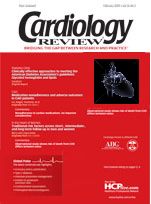Publication
Article
Cardiology Review® Online
Case report: A stroke patient with left atrial appendage
A 76-year-old man was admitted to the hospital and diagnosed with stroke caused by peripheral embolism. He underwent cardiac surgery 12 years earlier for replacement of mitral and aortic valves with biological prostheses. During surgery, left atrial appendage ligation was not performed and, although the prostheses implanted were biological, the patient received anticoagulant treatment with warfarin.
A computed tomography scan showed that the patient had a stroke, and transesophageal echocardiography (TEE) was performed to search for an embolic source. The echocardiographic study showed normal function of both prostheses and an enlarged left atrial appendage with spontaneous echo contrast and low appendage flow velocities. In addition, a thrombus located inside the left atrial appendage was found in the TEE study (Figure).
This patient developed a thrombus in the left atrial appendage despite treatment with anticoagulant therapy. This case illustrates a high-risk patient who would probably have benefited from surgical left atrial appendage li-gation during cardiac surgery. The absence of left atrial appendage ligation together with a low-flow velocity and spontaneous echo contrast are variables that, according to the findings of our study, are associated with increased stroke risk. n
